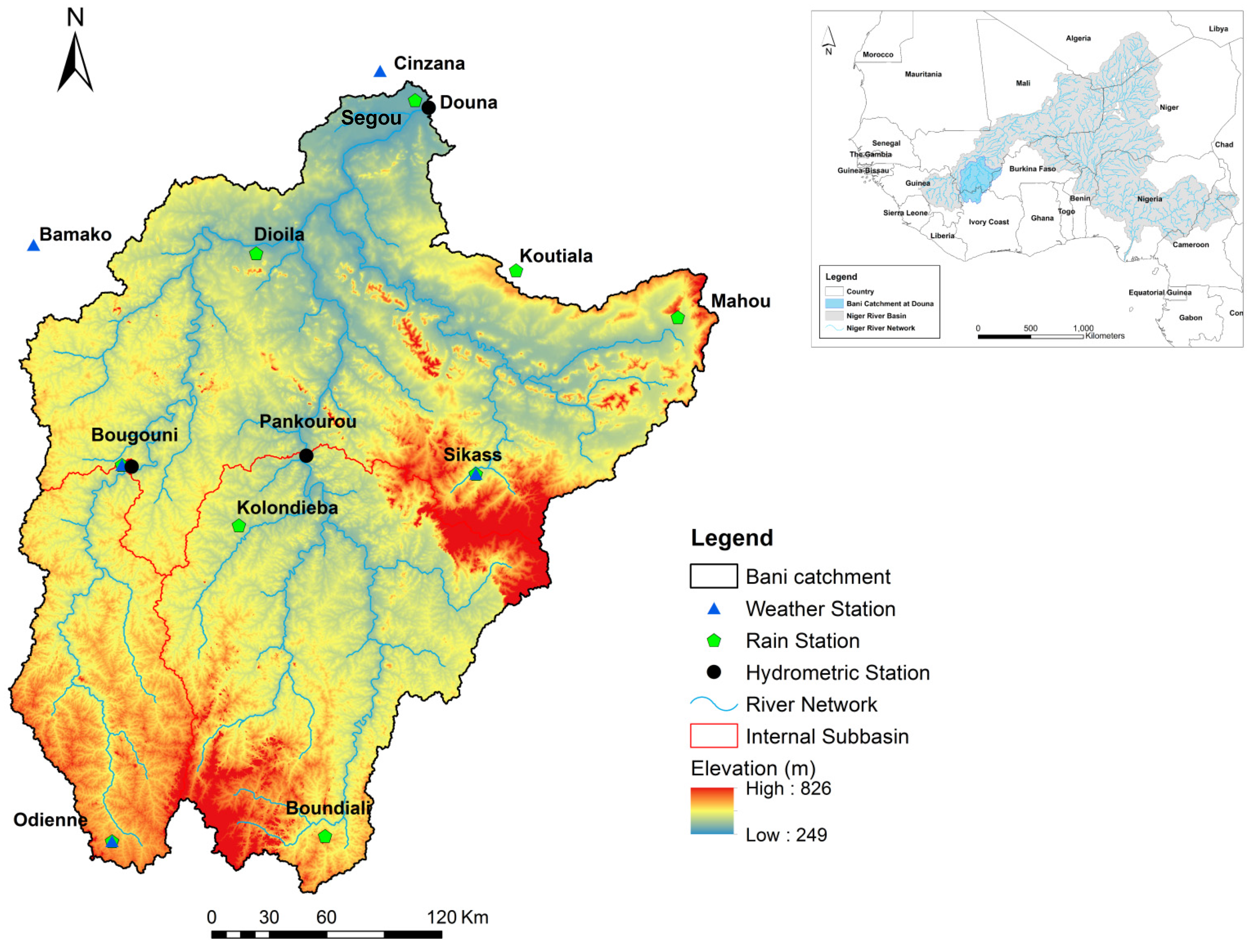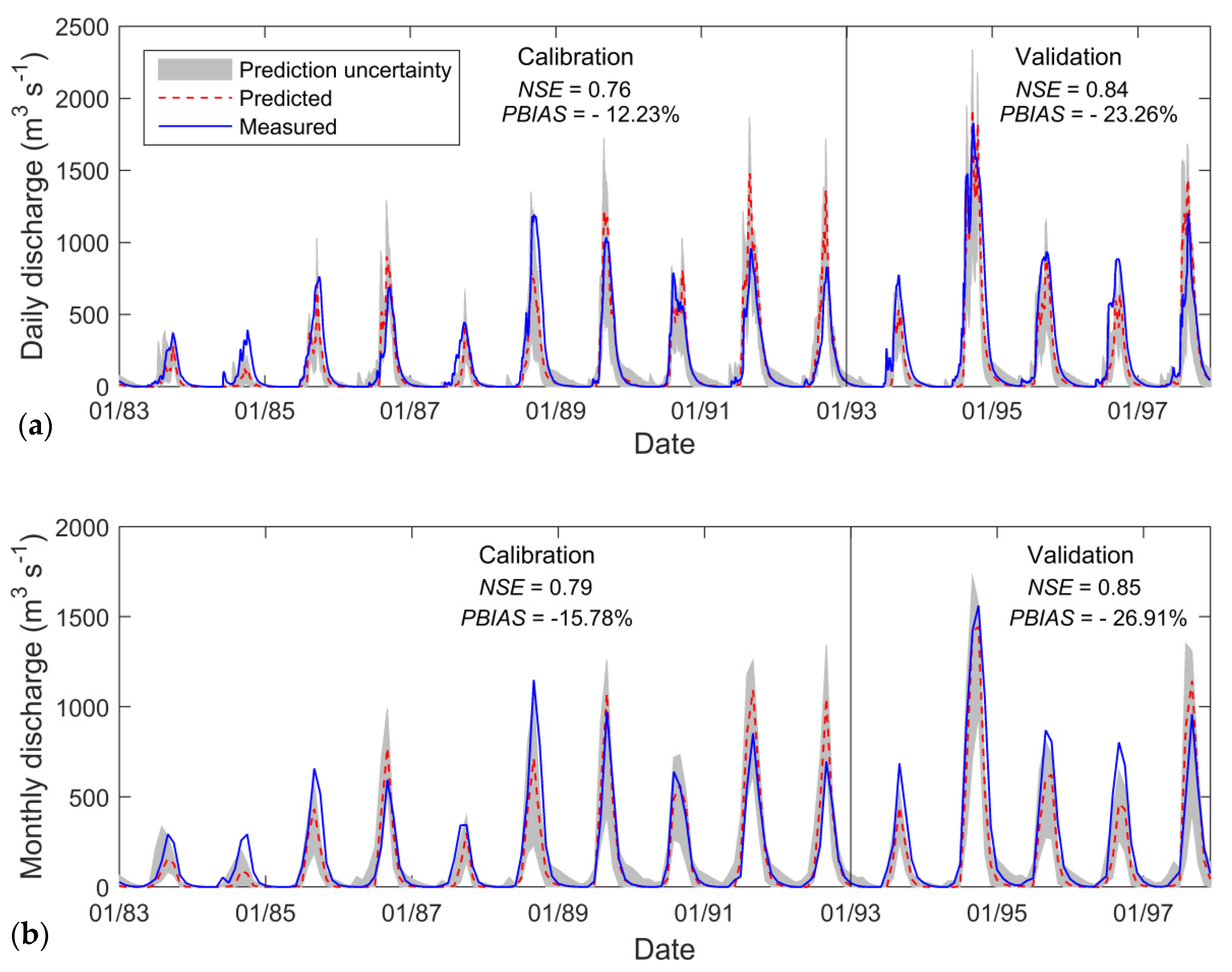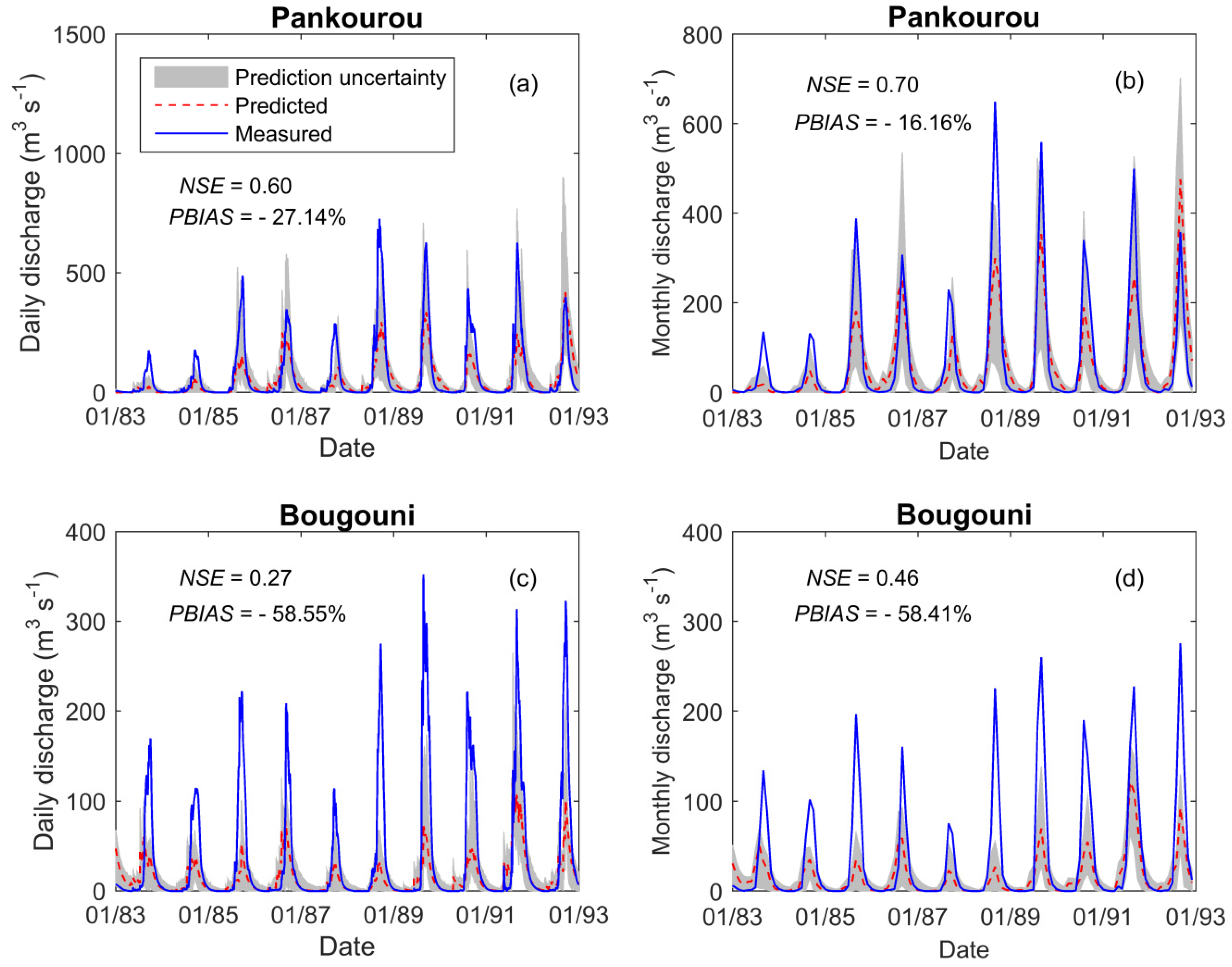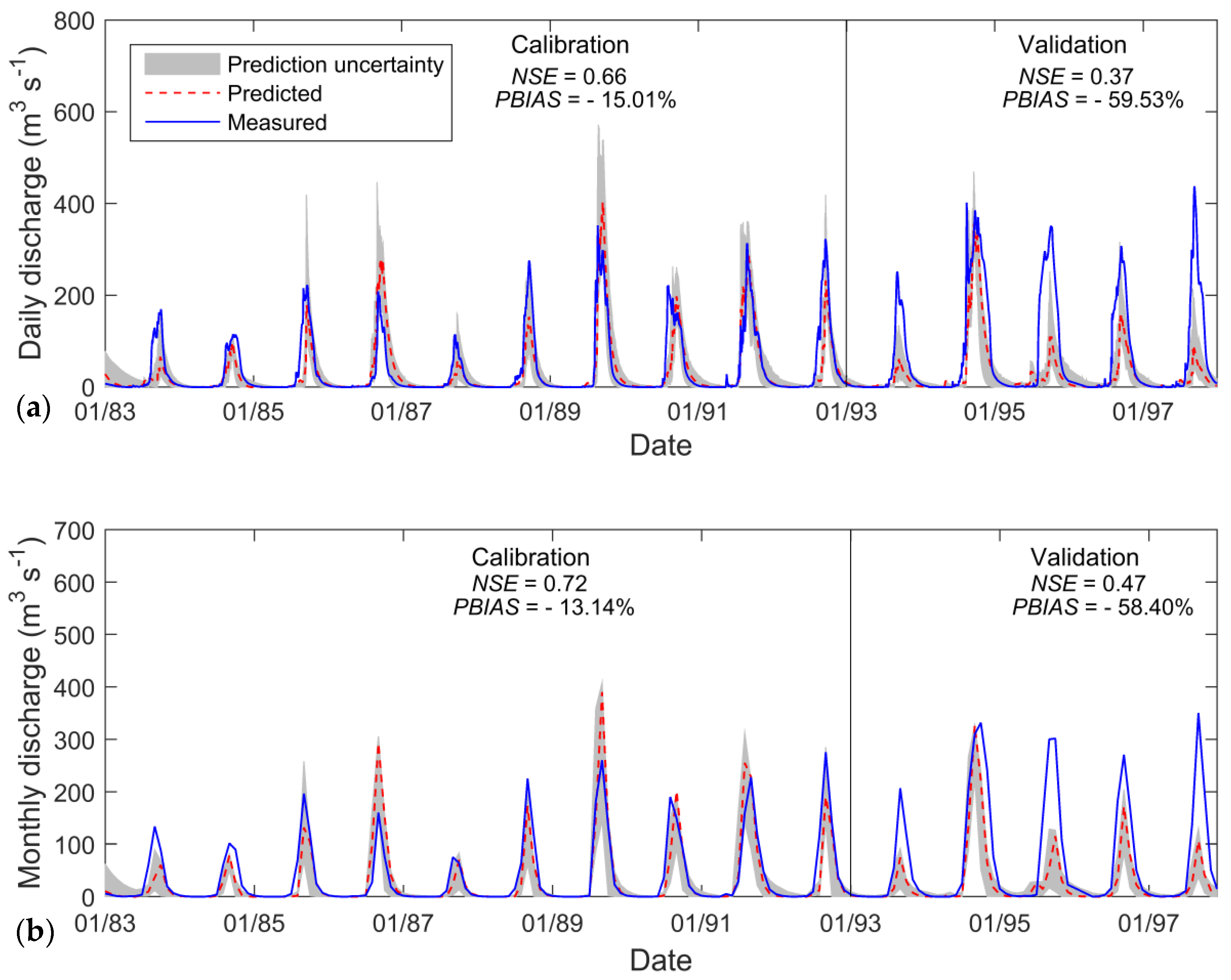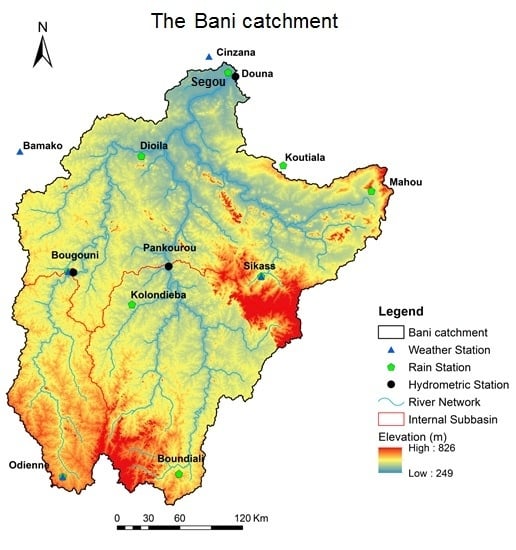1. Introduction
Water resources managers are facing challenges in many river basins across the world due to limited data availability. Anthropogenic activities add more uncertainties to this task by inducing changes to land and climate at different scales [
1,
2]. This situation is more pronounced in developing countries, where in many river basins no runoff data are available [
3,
4,
5,
6,
7] and the existing ones are of questionable quality or, at best, short or incomplete.
The Niger River basin is not an exception to that rule. The general situation of insufficient data is exacerbated by a deterioration of measurement networks. In the 80s and 90s, for instance, hydrometric stations were reduced to a minimum and many have been abandoned (e.g., [
8]). To prevent the hydrologic observing system from more degradation, the Niger Basin Authority (NBA) has set the Niger-HYCOS project, which one of its specific objectives is to improve data quality of the Niger Basin. For this purpose, the project identified and brings assistance in the installation and the management of 105 hydrometric stations shared by nine countries drained by the River, and contributes to the capacity building of national hydrological services.
In its fifth assessment report on regional aspects of climate change, the Inter-Governmental Panel on Climate Change [
9] has shown that adaptation to climate change in Africa is confronted with a number of challenges among which is a significant data gap. Too many basins lack reliable data necessary to assess, in details, impacts of climate change on different components of the hydrological cycle and to develop strategies of adaptation related to each specific impact. Thus, it is germane to predict hydrological variables in ungauged basins for building high adaptive capacity by improving: (i) water resources knowledge, planning, and management; (ii) identification and implementation of strategies of adaptation to climate change in the sector of water, and (iii) ecological studies for a sustainable development.
The application of rainfall-runoff models and then, transferring model parameters from gauged to ungauged catchments is a long-standing method [
10] for flow prediction in ungauged basins and has been highlighted during the decade of Prediction in Ungauged Basins (PUB) launched in 2003 by the International Association of Hydrological Sciences (IAHS) and concluded by the PUB Symposium held in 2012. This is the framework of the present study, in which the Soil and Water Assessment Tool (SWAT) model was calibrated on the Bani catchment (Niger River basin) and the most sensitive model parameters were estimated.
Many studies have successfully applied the SWAT model in West Africa, on different river basins. Examples include, among others: calibration of the SWAT model on the Niger basin [
11,
12,
13,
14,
15,
16], the Volta basin [
12,
13,
14,
15,
17,
18,
19] and the Oueme catchment in Benin [
15,
20,
21,
22]. However there are few published papers on the application of the SWAT model on the Bani catchment. For instance, Schuol and Abbaspour [
12] and Schuol
et al. [
14] applied the SWAT model to selected watersheds in West Africa including the Niger basin and modeled monthly values of river discharges (blue water) as well as the soil water (green water), and clearly showed the uncertainty of the model results. They developed and applied a daily weather generator algorithm [
13] that uses 0.5 degree monthly weather statistics from the Climatic Research Unit (CRU) to obtain time series of daily precipitation as well as minimum and maximum temperatures for each sub-basin. These generated weather data were then used as input for model setup and the authors concluded that “discharge simulations using generated data were superior to the simulations using available measured data from local climate stations”. Reported Nash-coefficient values obtained vary largely between sub-basins and were principally presented as average intervals limiting thus, our understanding of model performance at finer spatial (subbasin) and temporal (daily) scales.
Laurent and Ruelland [
23] successfully calibrated SWAT on the Bani catchment using daily measured climate data. They interpolated precipitation data on a regular grid by the Inverse Distance Weighted (IDW) method, which has proven to yield better results than kriging, Thiessen and spline methods, especially when a hydrological model is used [
24]. To show the model performance, Laurent and Ruelland [
23] reported both discharge and biomass calibration results on an average annual basis, but did not assess model calibration uncertainty. Moreover, both above-mentioned studies performed interpolation of input data out of the model framework to obtain a time series of daily weather data for each sub-basin. However, the results of interpolation methods are strongly influenced by the density and spatial distribution of the measurement stations used in the interpolation [
25]. Such a density of data is not always available in developing countries.
Against this background, the objective of this study was to assess the performance of the SWAT model and its predictive uncertainty on the Bani at catchment and subcatchment levels. More specifically, this meant to: (i) set up a hydrological model for the Bani catchment using the SWAT program; (ii) calibrate the model at the catchment outlet at daily and monthly time steps and assess the predictive performance and uncertainty; (iii) evaluate the spatial performance of the watershed-wide model within the catchment by validating it at two internal stations; and (iv) calibrate the model at the sub-catchments separately and provide a comparative assessment of the model performance at different spatial scales.
The originality of this study was the daily performance of the SWAT model at the whole catchment outlet and at two internal stations. Another important output of this paper was the involvement of evapotranspiration (the most important component of the water balance after rainfall especially under warm climate) in the verification of model outputs reasonability, a particular attention that has not been considered by any previous study in the region. In addition, we used in the current work point rain gauge data (as per SWAT’s standard procedure) opposed to areal precipitation as used in previous studies [
12,
13,
14,
15,
24,
26,
27] on the same basin in order to maintain the real data condition (limited in time and space) to the extent possible.
4. Discussion
4.1. Model Performance
In an effort to assess the performance of the SWAT model on the Bani catchment, we calibrated and validated the model at multiple sites on daily and monthly time steps by using measured climate data. There was no statistically significant difference in model performance among time intervals. Using guidelines given in Moriasi
et al. [
50], the overall performance of the SWAT model in terms of
NSE and
R2 can be judged as very good, especially considering limited data conditions in the studied area. On a monthly basis, we obtained at the Douna outlet a
NSE value equal to 0.79 for the calibration period (0.85 for the validation period). These results are greater than the ones of the studies by Schuol and Abbaspour [
12], and Schuol
et al. [
14] at the same outlet. Schuol and Abbaspour [
12] reported indeed a negative
NSE (between −1 and 0) for the monthly calibration and a value ranging between 0 and 0.7 for monthly validation, while Schuol
et al. [
14] obtained a
NSE between 0 and 0.70 for both monthly calibration and validation. However, Laurent and Ruelland [
23] reported a greater performance (
NSE values varying between 0.81 and 0.91 for calibration and validation period, respectively) but on a coarser time step (average annual basis). The water balance is less well simulated, especially for monthly time step with a
PBIAIS greater than 25% in absolute value.
The quantified prediction uncertainty is surprisingly satisfactory (
Table 6). At the end of the daily calibration, the model was able to account for 61% of observed discharge data (65% for monthly calibration) in a narrow uncertainty band. These results are close to the result of Schuol
et al. [
14] who estimated the observed discharge data bracketed by the 95PPU between 60% and 80% for monthly calibration (40% and 60% for monthly validation). However, one explanation that could be attributed to the small uncertainty band we obtained is that model predictive uncertainty derived by GLUE depends largely on the threshold value to separate “behavioral” from “non-behavioral” parameter sets [
63,
64].
This means, a high threshold value (as in this case) will generally lead to a narrower uncertainty band [
65,
66,
67] but this will be achieved at the cost of bracketing less observed data within the 95PPU band. In addition, GLUE accounts partly for uncertainty due to the possible non-uniqueness (or equifinality) of parameter sets during calibration and could therefore underestimate total model uncertainty [
68]. For instance, Sellami
et al. [
69] showed that the GLUE predictive uncertainty band was larger and surrounded more observation data when uncertainty in the discharge data was explicitly considered. Engeland and Gottschalk [
70] demonstrated that the conceptual water balance model structural uncertainty was larger than parameter uncertainty. In spite of all the aforementioned limitations of GLUE, we succeeded in enclosing interestingly most of the observed data within a narrow uncertainty band (the sought adequate balance between the two indices) hence increasing confidence in model results. These are encouraging results showing, on one hand, the good performance of the SWAT model on a large Soudano-Sahelian catchment under limited data and varying climate conditions and, on the other hand, the capability of observed climate and hydrological input data of this catchment, even though contested, to provide reliable information about hydro-meteorological systems prevailing in the region.
It has been also noted that the model did not perform well during the year 1984 particularly (lower performance and larger uncertainty). This loss of performance can be attributed to the disruption in rainfall-runoff relationship consequence of consecutive years of drought, which has prevailed in the beginning of the 80s. The over-predicted PET on the Bani catchment could be attributed to the Hargreaves method, which could give a greater estimate of PET than it actually is. Ruelland
et al. [
28] applied a temperature-based method given by Oudin
et al. [
71] and provided a similar estimate of PET (1723 mm) than the values calculated herein by the Penman and pan evaporation methods hence corroborating our results. These results demonstrated the valuable of pan evaporation measurements for estimating PET and that the simple pan evaporation method appears to be suited for application in the study area and can be used when all the climatic data required by the Penman method are missing.
As far as biomass is concerned, the underestimation of this component in savannah could be explained by inappropriate specification of all categories in the land use map grid to be modeled by SWAT as savannah or inaccurate savannah characteristics added in the SWAT database, directly affecting biomass production such as BIO_E and LAI parameters, among others.
4.2. Impact of Spatial and Temporal Scales on the Model Uncertainty
Results showed that transferring the model parameters from the catchment outlet (Douna) to the internal gauging stations performs reasonably well only in the case of similarity between donor and target catchments. The case of catchments controlled by Douna and Pankourou gives a clear example of such physical proximity where precipitation, soil and land use vary smoothly between both catchments. However, the SWAT model parameters determined at the outlet could not reproduce well the measured discharge at Bougouni mainly due to more significant spatial dissimilarities. Bougouni is indeed situated in a more humid zone and dominated by forest whereas Douna is more arid. Moreover, it has been demonstrated that the individual calibration at subcatchment scale has led to a narrower uncertainty band and more observed discharge data enclosed in it, which is the sought adequate balance between the two indices. Hence, predictive uncertainty was found to decrease with decreasing spatial scale. This finding can be attributed to the presence of less heterogeneity in hydrological variables in smaller catchments. These results showed the importance of the calibration of hydrological models at finer spatial scale to ensure that predominant processes in each subcatchment are captured, and this is particularly relevant in case of large-area global catchments. Concerning the effect of temporal scale, we demonstrated that the validation period is characterized by less predictive uncertainty as opposed to the calibration period. One explanation that can be given is the fact that 1993-1997 constitutes a more humid period than 1983-1992 and is characterized, therefore, by less variability in precipitation. In contrast, when moving from daily to monthly calibration, the uncertainty of the model, in terms of uncertainty band width, increased. This could be attributed to the cumulative effect of uncertainty in daily discharge data used to compute monthly discharge, resulting therefore in larger monthly uncertainty. Overall, due to decreasing prediction uncertainty with decreasing spatial and temporal scales, it is germane to develop on the basin a more efficient system of hydro-meteorological data collection to account for spatial and temporal variabilities in hydro-meteorological systems prevailing in the region, especially under changing climate and land use conditions.
4.3. Advance in Understanding of Hydrological Processes
The GSA confirms what has already been reported on and around the Bani catchment about the contribution of hydrological processes to streamflow generation. In order to better understand the origin of flows at Kolondieba (a tributary of the Bani River), Dao
et al. [
72] showed that Groundwater contribution to the hydrodynamic equilibrium at the outlet of watershed Kolondieba is small and the direct flow from the soil surface governs the runoff process. This fact can be explained by the double impact of a general impoverishment of shallow aquifers due to reduction in precipitation in West Africa in general since the great drought of the 70s as well as a concurrent increase of the recession coefficient of the Bani river as demonstrated by Bamba
et al. [
32] and Mahé [
73] with a decrease of baseflow contribution to total flow in absolute and relative values as corollary.
4.4. Spatial Performance
The results of different calibration and validation techniques showed varying predictive abilities of the SWAT model through scales. Firstly, it can be derived from these findings that model performance in terms of
NSE and
R2 was higher on the watershed-wide level than on the sub-watershed level. However, this could be attributed to compensation between positive and negative errors of processes occurring at a larger scale [
74,
75]. This suggests that calibrating a model only at the basin outlet leads to an overconfidence in its performance than at the sub-basin scale. Secondly, individual calibration of subcatchment processes expectedly improved model accuracy in predicting flows at the internal gauging stations, due to reducing heterogeneities with downsizing space [
76], and is especially beneficent while the donor and receiver catchments are substantially different. Finally, predictive uncertainty appears to decrease with reducing spatial scale, but increases with humidity as shown by the lower performance recorded at Bougouni. The inability of the model to perform during the validation period at Bougouni could be attributed to the structure of the validation period which is substantially different to that of calibration, and is solely composed by average to wet years while in contrast, the occurrence of dry, average, and wet years during the calibration period is noted.
These results have an important role to play in the calibration and validation approaches of large-area watershed models and constitutes a first step to model parameter regionalization for prediction in ungauged basins.
Generally speaking, it is well known that in recent decades the Niger River basin has suffered from a serious degradation of its natural resources, which in turn lead to severe environmental issues. To this end, different agreements and collaborations on water and climate data sharing have been established between the 9 countries sharing the basin through different national and international programs. Thus, the need to reinforce the existing framework of integrated, coordinated, and sustainable water management strategies in the Bani basin and therefore the Niger River Basin become more urgent than ever.
Therefore, this study is a step in that long-term direction, where an integrated water management tool has been developed and validated spatially on the Bani catchment, which allows investigation of future effects of land use and climate change scenarios on water resources.
5. Conclusions
In this study, the performance of the widely-used SWAT model was evaluated on the Bani catchment using both split-sample and split-location calibration and validation techniques on daily and monthly intervals. The model was calibrated at the Douna outlet and at two internal stations. Freely available global data and daily observed climate and discharge data were used as inputs for model simulation and calibration. Calibration, validation, uncertainty, and sensitivity analyses were performed with GLUE within SWAT-CUP. Both graphical and statistical techniques were used for hydrologic calibration results evaluation. Evapotranspiration and biomass production outputs were verified and compared to regional values to make sure these components were reasonably predicted. Sensitivity analysis contributed to a better understanding of the hydrological processes occurring at the study area.
Final results showed a good SWAT model performance to predict daily as well as monthly discharge at Douna with acceptable predictive uncertainty despite the poor data density and the high gradient of climate and land use characterizing the study catchment. However, the daily calibration resulted in less predictive uncertainty than the monthly calibration. The performance of the model is somehow lower at an internal sub-catchments level when the global parameter sets are applied, especially at the one with higher humidity and dominated by forest. However, subcatchment calibration induced an increase of model performance at intermediate gauging stations as well as a decrease of total uncertainty. With regard to predicted PET, this component is overestimated by the model when the Hargreaves method is applied in that specific region while biomass production remained low in the savannah land use category. The GSA revealed the predominance of surface and subsurface processes in the streamflow generation of the Bani River.
Overall, this study has shown the validity of the SWAT model for representing globally hydrological processes of a large-scale Soudano-Sahelian catchment in West Africa. Given the high spatial variability of climate, soil, and land use characterizing the catchment, additional calibration is however needed at subcatchment level to ensure that predominant processes are captured in each subcatchment. Accordingly, the importance of spatially distributed hydrological measurements is demonstrated and constitutes the backbone of any type of progress in hydrological process understanding and modeling. The calibrated SWAT model for the Bani can be used to assess the current and future impacts of climate and land use change on water resources of the catchment, increasingly necessary information awaited by water resources managers. Knowing this information, a strategy of adaptation in response to the current and future impacts can be clearly proposed and the vulnerability of the population can therefore be reduced. More widely, this impact study can increase the transferability of the model parameters from the Bani subcatchment to another ungauged basin with some similarities, and then predicting discharge without the need of any measurement. These findings are very useful, especially in West Africa, where many river basins are ungauged or poorly gauged.
